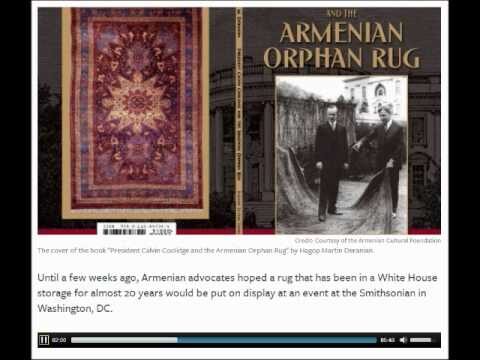WHITE HOUSE DISPLAY OF ARMENIAN ORPHAN RUG PRESENTS PRESIDENT OBAMA WITH CLEAR CHOICE
October 15, 2014WASHINGTON, DC — After long decades in storage, and following Congressional pressure and a nationwide ANCA campaign to secure its release, the White House has agreed to the display of the Armenian Orphan Rug, woven by orphan survivors of the Armenian Genocide and gifted to U.S. President Calvin Coolidge in 1925 in appreciation for U.S. humanitarian assistance following Turkey’s mass murder of over 1.5 million Armenians and other Christians, reported the Armenian National Committee of America (ANCA).
The White House has yet to announce if this exhibit will be accurately represented within the historical context of the Armenian Genocide, or whether it will represent yet another transparent pre-Centennial attempt by the Administration to appease Armenian Americans while still enforcing Ankara’s gag-rule against honest American discourse about this still-unpunished crime against humanity.
“The President has a clear choice to make,” said ANCA Executive Director Aram Hamparian. “If President Obama’s decision to publicly exhibit the Armenian Orphan Rug is to represent a symbol of real progress, the White House Visitor Center Exhibit will clearly and unequivocally reference the still unpunished crime that led to its creation – the Armenian Genocide.”
“If, on the other hand, the exhibit purposefully evades the rug’s proper characterization, the President’s decision to display this artwork will represent yet another cynical substitute for the very progress he promised the American people, further tightening Ankara’s gag-rule on the truthful commemoration of a crime against all humanity.”
According to a release issued by Rep. Adam Schiff (D-CA) earlier today, “the White House will be displaying the Armenian Orphan Rug, also known as the Ghazir Rug, as part of an exhibit at the White House Visitors Center. The exhibit – entitled “Thank you to the United States: Three Gifts to Presidents in Gratitude for American Generosity Abroad” – will showcase the Ghazir rug, as well as the Sèvres vase, given to President Herbert Hoover in appreciation for feeding children in post-World War I France, and the Flowering Branches in Lucite, given to President Barack Obama in recognition of American support of the people of Japan after the devastating earthquake and tsunami in 2010. These three gifts to American presidents will be on display so visitors to the White House and those wishing to see the artifacts can view them.”
The exhibit is scheduled to take place at the White House Visitor Center from November 18th to 23rd.
The Armenian Orphan Rug measures 11′ 7″ x 18′ 5″ and is comprised of 4,404,206 individual knots. It took Armenian girls in the Ghazir Orphanage of Near East Relief 10 months to weave. The rug was delivered to President Coolidge on December 4, 1925, in time for Christmas, with a label on the back of the rug, which reads “IN GOLDEN RULE GRATITUDE TO PRESIDENT COOLIDGE.”
According to Missak Kelechian, an expert on this topic, the gift of the Armenian Orphan rug was widely covered in U.S. media, including in the New York Times in 1925 and the Washington Post in 1926.
Additional information about the history of the Armenian Orphan Rug is available in Dr. Hagop Martin Deranian’s book, “President Coolidge and the Armenian Orphan Rug,” published on October 20, 2013, by the Armenian Cultural Foundation.
The controversy surrounding the Armenian orphan rug erupted in October, 2013, when the Washington Post and National Public Radio reported the White House’s abrupt and unexplained reversal of its agreement to lend the rug for a December 16, 2013, exhibition at the Smithsonian Institute, organized in cooperation with the Armenian Cultural Foundation and the Armenian Rug Society. In an interview with Public Radio International (PRI), Washington Post Art Critic Philip Kennicott noted that while the White House has not offered an explanation for the reversal in decision, it is likely due to the U.S. government’s deference to Turkey’s international campaign of genocide denial.
Following these initial reports, the ANCA organized a nationwide grassroots campaign, worked with Members of Congress, and consulted with the Administration, making the case to all relevant stakeholders for the prominent and permanent public display of this historic rug.
In November, 2013, a bipartisan group of over 30 U.S. Representatives, led by Representatives Schiff and Valadao, called on the White House to reverse its decision. Senator Markey and Representatives Brad Sherman (D-CA) and Nikki Tsongas (D-MA) also sent personal letters urging the White House to take action.
During an ANCA Western Region press conference timed with President Obama’s visit to Los Angeles on November 26, 2013, His Eminence Archbishop Moushegh Mardirossian, Prelate of the Western Prelacy of the Armenian Apostolic Church noted, “The rug was a gracious gesture symbolizing the friendship between the American and Armenian peoples. It is part of American history. Keeping it locked away in storage is not only insulting to the orphaned girls who painstakingly crafted this beautiful work of art, it also represents a shameful effort to cover up, at the urging of genocide-deniers in Ankara, a truly proud chapter of American history.”
The White House response at that time was vague – with National Security Staff Assistant Press Secretary Laura Lucas Magnuson offering the following comment to the Asbarez Armenian Newspaper: “The Ghazir rug is a reminder of the close relationship between the peoples of Armenia and the United States. We regret that it is not possible to loan it out at this time.” A statement with the same exact wording was released to the Washington Post at the time.
LA Times reporter Richard Simon reported a White House change of position on April 30, 2014, with Magnuson affirming that the White House has “been working with Congressman Schiff on this issue for several months and appreciate his working with us to showcase this important artifact in a way that appropriately highlights the spirit in which it was given to the White House for U.S. involvement in assisting Armenian refugees.”
Read Simon’s complete Los Angeles Times article here.


